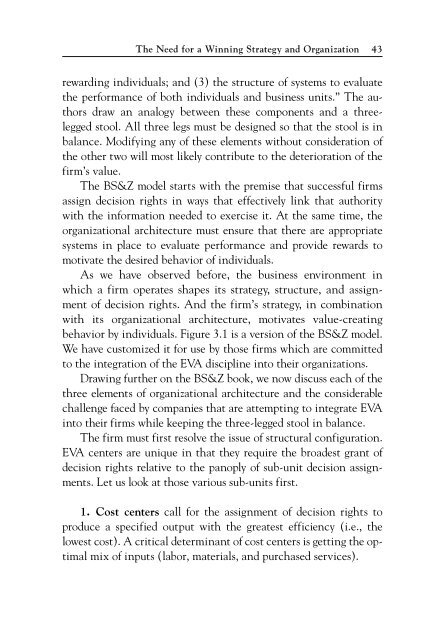The EVA Challenge: Implementing Value-Added Change in an ...
The EVA Challenge: Implementing Value-Added Change in an ...
The EVA Challenge: Implementing Value-Added Change in an ...
Create successful ePaper yourself
Turn your PDF publications into a flip-book with our unique Google optimized e-Paper software.
<strong>The</strong> Need for a W<strong>in</strong>n<strong>in</strong>g Strategy <strong>an</strong>d Org<strong>an</strong>ization 43<br />
reward<strong>in</strong>g <strong>in</strong>dividuals; <strong>an</strong>d (3) the structure of systems to evaluate<br />
the perform<strong>an</strong>ce of both <strong>in</strong>dividuals <strong>an</strong>d bus<strong>in</strong>ess units.” <strong>The</strong> authors<br />
draw <strong>an</strong> <strong>an</strong>alogy between these components <strong>an</strong>d a threelegged<br />
stool. All three legs must be designed so that the stool is <strong>in</strong><br />
bal<strong>an</strong>ce. Modify<strong>in</strong>g <strong>an</strong>y of these elements without consideration of<br />
the other two will most likely contribute to the deterioration of the<br />
firm’s value.<br />
<strong>The</strong> BS&Z model starts with the premise that successful firms<br />
assign decision rights <strong>in</strong> ways that effectively l<strong>in</strong>k that authority<br />
with the <strong>in</strong>formation needed to exercise it. At the same time, the<br />
org<strong>an</strong>izational architecture must ensure that there are appropriate<br />
systems <strong>in</strong> place to evaluate perform<strong>an</strong>ce <strong>an</strong>d provide rewards to<br />
motivate the desired behavior of <strong>in</strong>dividuals.<br />
As we have observed before, the bus<strong>in</strong>ess environment <strong>in</strong><br />
which a firm operates shapes its strategy, structure, <strong>an</strong>d assignment<br />
of decision rights. And the firm’s strategy, <strong>in</strong> comb<strong>in</strong>ation<br />
with its org<strong>an</strong>izational architecture, motivates value-creat<strong>in</strong>g<br />
behavior by <strong>in</strong>dividuals. Figure 3.1 is a version of the BS&Z model.<br />
We have customized it for use by those firms which are committed<br />
to the <strong>in</strong>tegration of the <strong>EVA</strong> discipl<strong>in</strong>e <strong>in</strong>to their org<strong>an</strong>izations.<br />
Draw<strong>in</strong>g further on the BS&Z book, we now discuss each of the<br />
three elements of org<strong>an</strong>izational architecture <strong>an</strong>d the considerable<br />
challenge faced by comp<strong>an</strong>ies that are attempt<strong>in</strong>g to <strong>in</strong>tegrate <strong>EVA</strong><br />
<strong>in</strong>to their firms while keep<strong>in</strong>g the three-legged stool <strong>in</strong> bal<strong>an</strong>ce.<br />
<strong>The</strong> firm must first resolve the issue of structural configuration.<br />
<strong>EVA</strong> centers are unique <strong>in</strong> that they require the broadest gr<strong>an</strong>t of<br />
decision rights relative to the p<strong>an</strong>oply of sub-unit decision assignments.<br />
Let us look at those various sub-units first.<br />
1. Cost centers call for the assignment of decision rights to<br />
produce a specified output with the greatest efficiency (i.e., the<br />
lowest cost). A critical determ<strong>in</strong><strong>an</strong>t of cost centers is gett<strong>in</strong>g the optimal<br />
mix of <strong>in</strong>puts (labor, materials, <strong>an</strong>d purchased services).

















